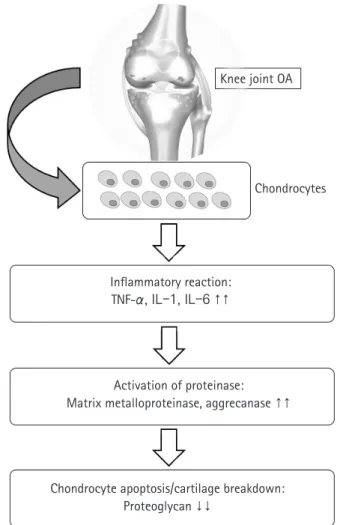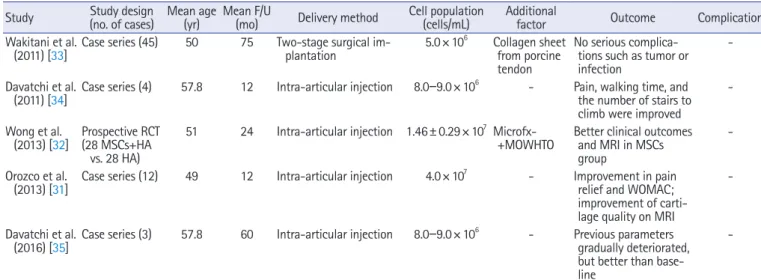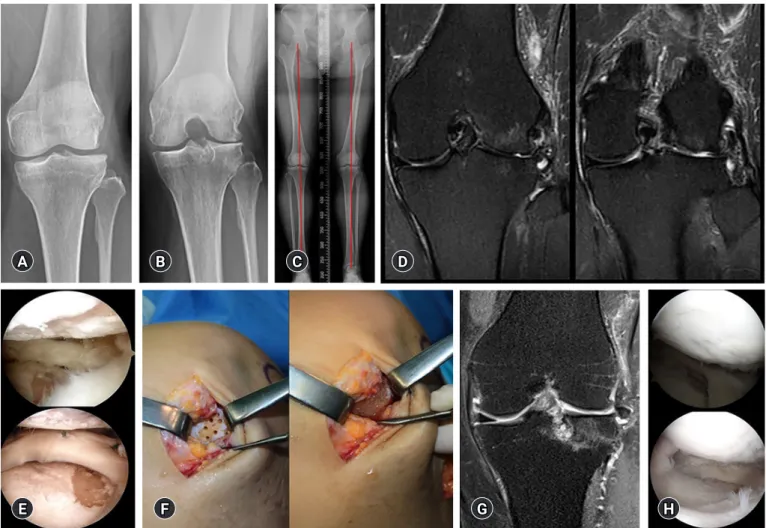Introduction
Osteoarthritis (OA) is a degenerative joint disease characterized by loss of cartilage, osteophyte formation, and periarticular bone change, resulting in disability [1,2]. In order to establish the dis- ease-modifying strategies of OA, it is necessary to understand the biomolecular features seen in OA circumstance. Increased proin- flammatory cytokines such as interleukin-1 or tumor necrosis fac- tor-α, decreased growth factors such as transforming growth fac- tor-beta (TGF-β), activated matrix metalloproteinase, and ulti- mate chondrocyte senescence can be observed at the molecular level [3-5] (Fig. 1). Although disease-modifying OA strategies that block inflammatory pathways and enhance cartilage protec- tive function have been developed recently [6,7], their effects on preventing the progression of OA have been still unsatisfactory, and it is particularly difficult to achieve ultimate cartilage regener- ation [8].
Mesenchymal stem cells (MSCs) are emerging as an attractive option for osteoarthritis (OA) of the knee joint, due to their marked disease-modifying ability and chondrogenic potential. MSCs can be isolated from various organ tissues, such as bone marrow, adipose tissue, synovium, um- bilical cord blood, and articular cartilage with similar phenotypic characteristics but different proliferation and differentiation potentials. They can be differentiated into a variety of connective tissues such as bone, adipose tissue, cartilage, intervertebral discs, ligaments, and muscles. Al- though several studies have reported on the clinical efficacy of MSCs in knee OA, the results lack consistency. Furthermore, there is no consensus regarding the proper cell dosage and application method to achieve the optimal effect of stem cells. Therefore, the purpose of this study is to re- view the characteristics of various type of stem cells in knee OA, especially MSCs. Moreover, we summarize the clinical issues faced during the application of MSCs.
Keywords: Knee joint; Mesenchymal stem cells; Osteoarthritis; Stem cells
Current perspectives in stem cell therapies for osteoarthritis of the knee
Gi Beom Kim, Oog-Jin Shon
Department of Orthopedic Surgery, Yeungnam University College of Medicine, Daegu, Korea
Yeungnam Univ J Med 2020;37(3):149-158 https://doi.org/10.12701/yujm.2020.00157
Received: March 12, 2020 Revised: April 1, 2020 Accepted: April 1, 2020 Corresponding author:
Oog-Jin Shon
Department of Orthopedic Surgery, Yeungnam University College of Medicine, 170 Hyeonchung-ro, Nam-gu, Daegu 42415, Korea Tel: +82-53-620-3640 Fax: +82-53-628-4020
E-mail: maestro-jin@hanmail.net
Meanwhile, since articular cartilage has a limited capacity for spontaneous healing, once damaged, it may eventually progress to OA [9]. Numerous attempts for the regeneration of focal cartilage defect have been made. Depending on the degree of defect size, various surgical options have been used, including multiple drill- ing, microfracture, abrasion chondroplasty, autologous chondro- cyte implantation, and osteochondral autologous transplantation [10-13]. However, there has been no optimal regenerative meth- od for cartilage in knee OA.
Recently, mesenchymal stem cells (MSCs) have been in the spotlight for their disease-modifying and chondrogenic potential along with their ease of harvesting, safety, and differentiation po- tential into cartilage [14,15]. Moreover, MSCs have been known to have paracrine and immunomodulatory effects through the se- cretion of cytokines and growth factors [16-19].
Therefore, considering the immunomodulatory and regenera- tive effect, stem cell therapies might be a promising line of treat-
Copyright
©
2020 Yeungnam University College of MedicineThis is an Open Access article distributed under the terms of the Creative Commons Attribution Non-Commercial License (http://creativecommons.org/licenses/by-nc/4.0/) which permits unrestricted non-commercial use, distribution, and reproduction in any medium, provided the original work is properly cited.
ment for knee OA. The purpose of this study was to review the characteristics of various type of stem cells in knee OA, especially based on MSCs. Moreover, we summarized the clinical issues for application of MSCs (Fig. 2).
General characteristics of stem cells
In general, stem cells can be divided into two major groups: (1) embryonic stem cells (ESCs) from the inner cell mass of blasto- cyst, with totipotency or pluripotency; (2) adult stem cells (tis- sue-specific stem cells) from specific organ, with multipotency [20,21]. Although adult stem cells have usually more restricted differentiation capacity compared to ESCs, they exhibit some ad- vantages including safety, easy derivation, and tissue-specific dif- ferentiation potential [22]. Among them, MSCs appears to be the promising candidates.
MSCs are multipotent progenitor cells that can be obtained from bone marrow, adipose tissue, synovial membrane, and artic- ular cartilage [23]. Several studies report their multidirectional differentiation potential [24,25]. Particularly, autologous MSCs can be easily harvested and applied in clinical settings, and allo- genic cells can be utilized [14,19]. Culture expansion may be re- quired to maximize their clinical effect [14], although that may re- sult in functional deterioration, mutation, and tumorigenesis as passage progresses. Nevertheless, MSCs can be cultivated and amplified while maintaining their potential, and differentiated into a variety of connective tissues such as bone, adipose tissue, Knee joint OA
Chondrocytes
Inflammatory reaction:
TNF-α, IL-1, IL-6 ↑↑
Activation of proteinase:
Matrix metalloproteinase, aggrecanase ↑↑
Chondrocyte apoptosis/cartilage breakdown:
Proteoglycan ↓↓
Fig. 1. Molecular mechanisms of osteoarthritis (OA). TNF, tumor necrosis factor; IL, interleukin.
BMAC BM-MSCs AD-MSCs S-MSCs hUCB-MSCs
Injective treatment
Source?Dose?
Clinical application?
Complication?


